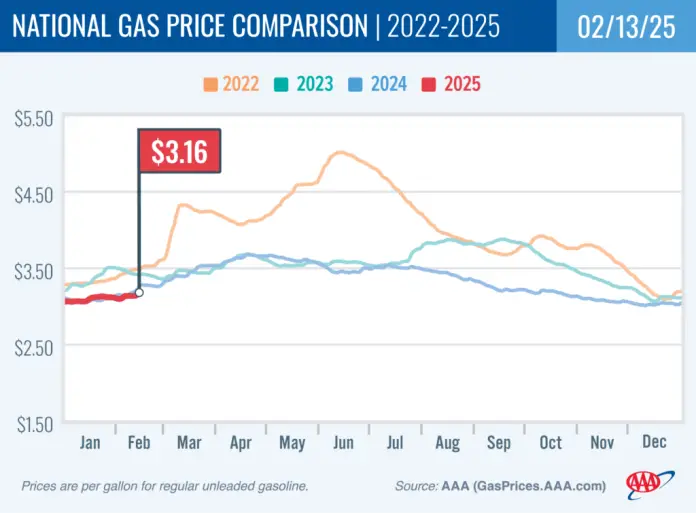As spring nears, small business owners face the season’s first significant hike in gas prices, a trend that could impact operational costs and customer spending. The most recent data indicates a rise in the national average gas price to $3.16 per gallon, reflecting a modest increase of 10 cents compared to last month, but down 6 cents from last year. The factors behind these fluctuations are essential considerations for small businesses relying on transportation and logistics.
Seasonal shifts in fuel production directly affect prices. Refineries are transitioning to summer blend fuel, which is generally more expensive to produce and refine. This seasonal transition often results in higher consumer prices, particularly as demand begins to increase. The Energy Information Administration (EIA) recently reported a rise in gasoline demand from 8.32 million barrels per day last week to 8.57 million, further tightening supply. The domestic gasoline supply has contracted from 251.1 million barrels to 248.1 million, while production has ramped up slightly, averaging 9.3 million barrels per day.
For small businesses, understanding these developments can provide invaluable insight into managing operational budgets and customer pricing strategies. According to industry experts, “Routine seasonal maintenance and an offline refinery in Northern California are putting additional strain on supply.” These factors may suggest that gas prices could rise further as warmer months approach, potentially affecting everything from delivery costs to employee transportation.
One opportunity for businesses is to evaluate their fleets and consider cost-saving measures. For instance, investing in fuel-efficient vehicles or implementing telematics can help optimize routes and reduce fuel consumption, ultimately mitigating the impact of rising prices. Furthermore, businesses in regions where gas prices are rigorously climbing, such as California ($4.79 average) and Hawaii ($4.55 average), may want to explore alternative energy options or local partnerships that could buffer customers against high fuel prices.
In contrast, states like Mississippi ($2.68) and Texas ($2.74) offer lower gas prices, providing more flexibility for businesses in those regions. Keeping an eye on local market trends can serve as a guide for strategic decision-making regarding operational costs.
Another aspect to consider is the cost of electricity associated with electric vehicle (EV) charging. The national average remains steady at 34 cents per kilowatt hour at public charging stations, despite the fluctuations in gas prices. As companies evaluate long-term sustainability practices, adding EVs to fleets and monitoring charging costs could present a viable strategy. Particularly in states with low charging costs, such as Kansas (22 cents) and Nebraska (24 cents), companies can save on operational expenses and appeal to eco-conscious consumers.
Small business owners should also be aware of potential challenges concerning the balance between pricing strategies and customer demand. As prices at the pump increase, consumers may adjust their spending habits, which could influence sales across various sectors. Maintaining transparency with customers about price changes while also prioritizing customer service may help mitigate dissatisfaction and retain loyalty.
To navigate these volatile market conditions effectively, small business owners can rely on resources like the AAA TripTik Travel planner, which assists drivers in locating current gas and electric charging prices along their routes. Such tools can prove beneficial for businesses involved in logistics and transport, enabling them to make more informed decisions.
Ultimately, staying proactive in response to rising gas prices and fluctuations in energy costs allows small businesses not only to manage their expenses but also to strategize for the future. By considering options such as sustainable vehicle investments and optimizing operational processes, businesses can continue to thrive despite external market pressures.
For more detailed statistics and a comprehensive breakdown of current fuel prices, access the original report from AAA at https://gasprices.aaa.com/right-on-cue-seasonal-trends-nudge-gas-prices-higher/.
Image Via AAA



